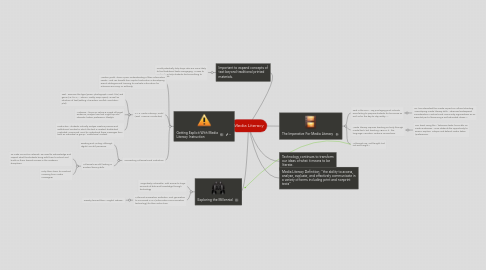
1. Important to expand concepts of text beyond traditional printed materials.
1.1. Could potentially help boys, who are more likely to find traditional texts unengaging. Access to content can help students find something to engage with.
2. Exploring the Millennial
2.1. "cognitively vulnerable" with access to huge amounts of data and knowledge through technology
2.2. Millennial Generation Definition: First generation to immersed in ICT (information communication technology) for their entire lives.
2.2.1. Prensky termed them "Digital Natives"
3. Getting Explicit With Media Literacy Instruction
3.1. Modern youth "have a poor understanding of their information needs." and can benefit from explicit instruction in developing search strategies and learning to evaluate information for relevance accuracy, or authority.
3.2. T.A.P. Media Literacy Model (Text, Auience, Production)
3.2.1. Text - examine the type (poem, photograph, novel, film) and genre (i.e. for TV - sitcom, reality, soap opera), as well as structure of text (setting, characters, conflict, resolution, plot)
3.2.2. Audience - focus on nature & needs of target audience; analyze how text might tap into interests, tastes, preference, lifestyle
3.2.3. Production - students critically analyze creative process and institutional context in which the text is created, distributed marketed, consumed. Goal to understand these messages from both an individual & group / institutional context.
3.3. Connecting Millennials and Instruction
3.3.1. Reading and Writing, although digital, are still pervasive.
3.3.2. Millennials are still lacking in acadeic literacy skills.
3.3.2.1. To make curriculum relevant, we need to acknowledge and respect what the students bring with them to school and build on them toward success in the academic disciplines.
3.3.2.2. Help them learn to construct meaning from media messages!!
4. Technology continues to transform our ideas of what it means to be literate.
5. Media Literacy Definition: "the ability to access, analyze, evaluate, and effectively communicate in a variety of forms including print and nonprint texts"
6. The Imperative For Media Literacy
6.1. Said in the 60's - "By privileging print, schools were failing to prepare students for tomorrow as well as for the day-to-day reality..."
6.1.1. ICT has intensified this media impact on culture/schooling. "Developing media literacy skills...'deserved widespread consideration in schools and community organizations as an essential part of becoming a well-educated citizen.'"
6.2. Media literacy requires teaching not only through media/tech, but teaching ABOUT it - the language, narrative, codes & conventions.
6.2.1. Can teach using film / television texts, focus attn on media audiences - Give students the opportunity to exaine, explore, critique and defend media tastes /preferences.
